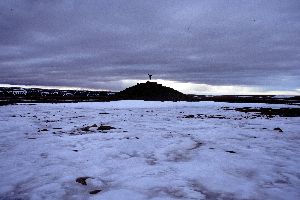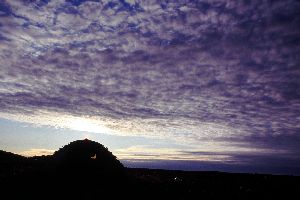Mon July 19:
At 6am the sun breaks through below a cloud bank and the tent is instantly too hot. Alfred is outside, trying to create artificial shade, using his sleeping bag to cover the tent’s dome – I doze restlessly, fighting fatigue of cold. Being sick is always a drag but never more so then when out on the land.
Yesterdays climb up continues…it’s a gradual ascent out of the valley from about 250’ elevation about 1500’ elevation, the rolling top of the uplands. There is no trail, we just pick our way through the path of least resistance. It’s dry scree, fairly stable footing (if one avoids the loose tumbled rock) but I’m still glad for the hiking poles. When the sun comes out, it’s hot. We are conserving water, not knowing when or where we will find it again.
Finally, after making a false descent and too early climb, we crest the last ridge and reach top. There is no peak at the summit but rather a flat featureless table top that stretches as far as one can see, no notable landmarks except for the occasional snow patch. Kilometers of evenly crushed and monochromatic colour rock is not inspiring: spending nine days wandering about doesn’t interesting. There is absolutely no vegetation. Mud oozes where snow has recently melted, the dog shit colour an unappealing gumbo.
We hop from rock to rock, trying to keep our feet dry and mud free. The mud is sticky and clumps to our boots. Yuk! Navigation on such a featureless plain is a challenge. We guesstimate distances and direction by using the distant peaks of the Sverdrup Glacier, 15 to 30 km away as markers. With the curve of the earth and the light conditions, views of the huge glacial side wall merge with the sky: it’s hard to distinguish the terrestrial from the heavenly. Plodding forward, with the eye lulled into meditative mood, the body slips into auto pilot and the kilometers go by. If fog or dense clouds roll in, we will stop and camp immediately, being essentially navigation blind.
Eventually we tire and start looking for a campsite. There is not much choice with so much broken rock surface, snow or mud. A sort of level area among a gravel pile looks promising – tiny lichen and saxifrage dot the surface, the first post glacial plant colonists. The sharpest rocks are removed in an effort to save the tent floor and more importantly, avoid puncturing the thermorests.
A pingo, 15 minutes walk away, offers the only vantage point with elevation. We get a better fix as to our relative location as well as a better idea of tomorrow’s direction. Fantastic views of the Sverdrup Glacier – a large cracks fissure its side flank, jewel tone hues of blue and emerald dazzle the eye. At the top, a tiny bird skull is nestled between rock cracks likely carried up by either a fox or owl. Nothing moves, not a snow bunting, a gull, a leaf, a twig. Not a whisper of sound. It’s an unnerving sensory isolation chamber except for the 360 degree view.

Our cooking and drinking water is obtained from two sources: snow is plentiful, soggy and quickly melted. But I prefer to collect the tiny rivulets of water that trickle between the rocks. It’s slow and tedious, sometimes a bit muddy, but feels more in harmony with the sterile timeless environment.
By 10pm I’m contemplating the day, writing the journal, Alfred is off exploring a 3rd distant pingo. The sun is in and out of a cloud bank, with no wind, the tent is either too hot or too cold, feeling fussy, I shut my eyes for a moment and its lights out.
